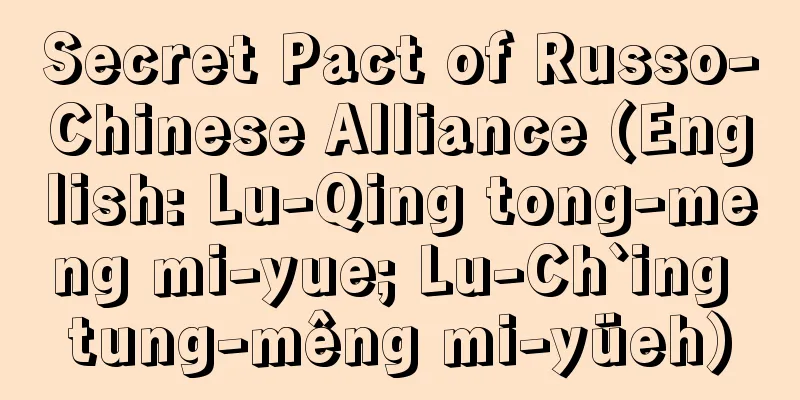Wasanbon

|
A sugar made by repeatedly squeezing the semi-solid, or semi-liquid, shiroshitato sugar (mixed with fine crystal particles) made by boiling down the juice of sugarcane, after adding water. It is pale yellow in color and has very fine crystals. It has a unique flavor and is used as an ingredient in high-end Japanese sweets. It is also called Sanbon Shiro or Washiro. Wasanbon was first made during the Edo period. When the eighth shogun, Tokugawa Yoshimune, encouraged sugar production, this was the sugar that became successful in Shikoku. It is still made mainly in Kagawa and Tokushima prefectures today. There are several theories about the origin of the name Sanbon, including that it comes from the fact that in ancient China, sugar was crushed three times on a tray (earthenware bowl) to refine it, or that it comes from the Chinese official rank of Sanbon (three ranks) who introduced the manufacturing method. The name Wasanbon means "Japanese-made," as opposed to sugars such as Sanbon Shiro that were imported from China. The manufacturing process involves first squeezing the sugar juice from the sugarcane, then heating and concentrating it (white sugar). This is then wrapped in a linen bag, several of which are then stacked and placed in a wooden frame, where it is compressed to extract the molasses. The sugar in the bag is then removed, mixed with a small amount of water, kneaded well, and then placed back in the linen bag and pressed. This is done five or six times to produce fine-grained white sugar. [Tomomi Kono and Midori Otaki] Research into domestic sugar began in 1726 (Kyoho 11), when Tokugawa Yoshimune distributed sugarcane seedlings to various feudal domains and encouraged their cultivation. However, in reality, there were no notable results other than the Satsuma domain producing brown sugar. 42 years later, in 1768 (Meiwa 5), Ikegami Yukitoyo succeeded in producing a small amount of Sanuki Wasanbon, and then in 1790 (Kansei 2), Mukaiyama Shukei recorded the production of several dozen jin of Sanuki Wasanbon. Meanwhile, Maruyama Tokuya, said to be the founder of Awa Wasanbon, traveled alone to Hyuga Province (Miyazaki Prefecture) in both 1776 (Anei 5) and 1792 (Kansei 4) to learn sugar manufacturing techniques. The result was Awa Washinbon, which achieved success in 1805 (Bunka 2). Normally, white sugar is made by removing the syrup from a mixture of sucrose crystals and syrup, called shiroshitato, using centrifugation, and this is called sanbon white or sanbon, but when used to make bon confectionaries, shiroshitato that has not had the syrup removed is highly valued. Slightly yellowish wasanbon sugar is used in famous products such as "Kinuta" from Chokyudo in Kyoto, "Yumochi" from Tsuruya Yoshinobu, "Saoshika" from Fujiya in Tokushima City, and "Choseiden" from Kanazawa, Ishikawa Prefecture. Uchigashi made only with wasanbon include "Ochiyobo" from Kamesuehiro in Kyoto and Nagoya, "Ninnin Shizuka" from Ryoguchiya in Nagoya, and "Wasanbon" from Fujiya in Tokushima City, all of which are known as famous products. [Fumio Sawa and Midori Otaki] [Reference items] | | | | | | |Source: Shogakukan Encyclopedia Nipponica About Encyclopedia Nipponica Information | Legend |
|
サトウキビの搾り汁を煮つめてつくった半固形状、あるいは微結晶粒子の混ざった半流動の白下糖(しろしたとう)に、水を加えて昔ながらの製法で圧搾することを繰り返してつくった砂糖。色は淡黄色で、結晶はたいへん細かい。独特の風味をもち、高級和菓子の原料に用いられる。三盆白、和白ともいう。和三盆が初めてつくられたのは江戸時代である。8代将軍徳川吉宗(よしむね)が製糖を奨励したとき、四国で成功したのがこれである。いまも主として香川県、徳島県でつくられている。三盆の語源については、昔、中国で、精白のために盆(土製の鉢)の上で3回もんだからとか、製法を伝えた中国人の官位三品(さんぼん)に由来するなどの説がある。和三盆の名称は、中国輸入の三盆白などの砂糖に対する和製の意である。 製法は、まず甘蔗(かんしょ)(サトウキビ)から糖液を搾り、これを加熱濃縮(白下糖)する。これを麻布の袋に包み、何個も重ねて木枠に入れ、圧縮して糖蜜分を搾り分ける。袋の中の砂糖は取り出して、少量の水を加えてよくもみ、ふたたび麻袋に入れて圧搾する。これを5、6回行うと、粒子の細かい白い砂糖がとれる。 [河野友美・大滝 緑] 国産砂糖は1726年(享保11)、徳川吉宗が諸藩にサトウキビの苗を配付、栽培を奨励して以来、研究が始められた。しかし実際には薩摩(さつま)藩が黒糖を生産していたほかはみるべき成果があがらなかった。それから42年後の1768年(明和5)、池上幸豊(ゆきとよ)が少量ながら讃岐(さぬき)和三盆の製造に成功、ついで1790年(寛政2)に向山周慶(さきやましゅうけい)が数十斤の讃岐和三盆の製造を記録した。一方、阿波(あわ)和三盆の祖といわれる丸山徳彌(とくや)は、1776年(安永5)と1792年(寛政4)の両度にわたり日向(ひゅうが)国(宮崎県)に単身赴いて製糖技術を身につけた。その結果、成功を収めたのが阿波和三盆で、1805年(文化2)のことであった。 普通、白砂糖は、白下糖とよばれるショ糖結晶と蜜(みつ)分の混合物から、遠心分離で蜜分を除去したもので、これを三盆白または三盆というが、盆菓子づくりに用いる場合、白下糖から十分に蜜分を除かない状態のものが珍重される。やや黄色味を帯びた和三盆糖は京都の長久堂の「きぬた」、鶴屋吉信(つるやよしのぶ)の「柚餅(ゆもち)」、徳島市の富士屋の「小男鹿(さおしか)」、石川県金沢の「長生殿」など名品に使われている。和三盆だけを用いた打ち菓子に、京都、名古屋の亀末広(かめすえひろ)の「お千代宝(ちよぼう)」、名古屋の両口屋の「二人静(ににんしずか)」、徳島市の富士屋の「和三盆」などがあり、名品として知られる。 [沢 史生・大滝 緑] [参照項目] | | | | | | |出典 小学館 日本大百科全書(ニッポニカ)日本大百科全書(ニッポニカ)について 情報 | 凡例 |
Recommend
Reinforcement
...This salivation is called a conditioned reflex...
Interference spectroscope
A spectroscope that uses the interference of ligh...
Pengcheng Hyakusen - Sakaki Hyakusen
Year of death: August 25, 2nd year of the Horeki e...
Szálasi F.
…In World War II, Hungary fought on the side of t...
Space station - Uchuusuteishon (English spelling) space station
A manned space facility for conducting research a...
Baseball
…One of the athletic sports. It is called basebal...
Bottom dead center - Kasten
...In addition, magnetic ignition devices that us...
Hell, Stefan
Born: 23 December 1962. Arad, Romania-born German ...
decortication posture
…Individual damage to this system is unlikely, bu...
Amis
…Although he also wrote long epic poems, his spec...
Kitayama Yakushi
…Oshio is home to Oshiourabandai Onsen (weakly sa...
Dreiperiding system
...He made great contributions as a museum man, s...
ANZAC - Anzac
The abbreviation for Australian and New Zealand Ar...
Lotzer, S.
…Among these peasant groups, the idea of “Divin...
Sanehiko Yamamoto
Publisher. Founder of Kaizosha. Born in Kagoshima...









